Page 1639 of 2103
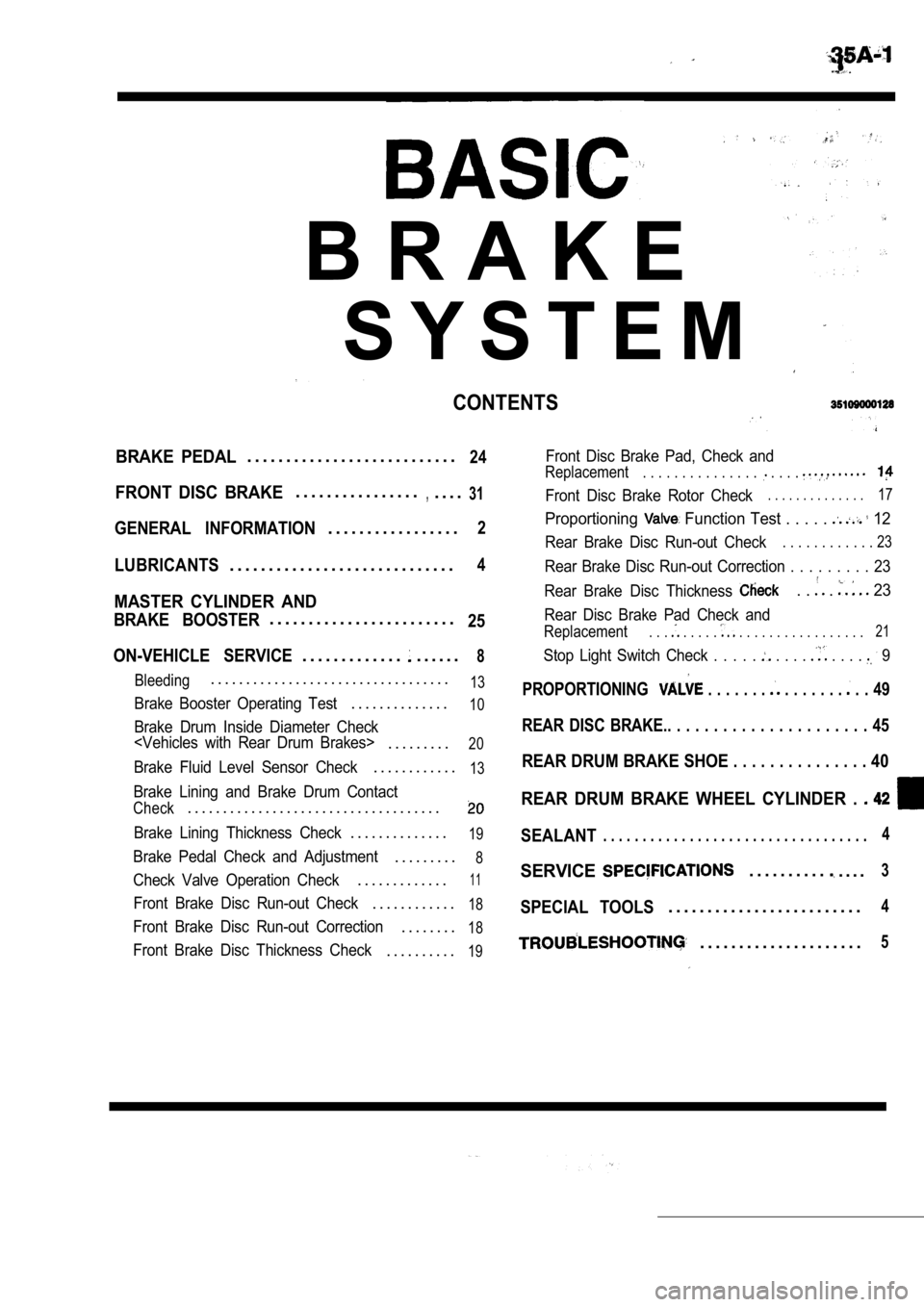
B R A K E
S Y S T E M
CONTENTS
BRAKE PEDAL. . . . . . . . . . . . . . . . . . . . . . . . . . .24
FRONT DISC BRAKE. . . . . . . . . . . . . . . .,. . . .31
GENERAL INFORMATION. . . . . . . . . . . . . . . . .2
LUBRICANTS. . . . . . . . . . . . . . . . . . . . . . . . . . . . .4
MASTER CYLINDER AND
BRAKE BOOSTER. . . . . . . . . . . . . . . . . . . . . . . .25
ON-VEHICLE SERVICE
. . . . . . . . . . . . .. . . . . .8
Bleeding. . . . . . . . . . . . . . . . . . . . . . . . . . . . . . . . . .13
Brake Booster Operating Test. . . . . . . . . . . . . .10
Brake Drum Inside Diameter Check
. . . . . . . . .20
Brake Fluid Level Sensor Check. . . . . . . . . . . .13
Brake Lining and Brake Drum Contact
Check. . . . . . . . . . . . . . . . . . . . . . . . . . . . . . . . . . . .
Brake Lining Thickness Check. . . . . . . . . . . . . .19
Brake Pedal Check and Adjustment. . . . . . . . .8
Check Valve Operation Check. . . . . . . . . . . . .11
Front Brake Disc Run-out Check. . . . . . . . . . . .18
Front Brake Disc Run-out Correction. . . . . . . .18
Front Brake Disc Thickness Check. . . . . . . . . .19
Front Disc Brake Pad, Check and
Replacement. . . . . . . . . . . . . . . . . . .
Front Disc Brake Rotor Check. . . . . . . . . . . . . .17
Proportioning Function Test . . . . . 12
Rear Brake Disc Run-out Check. . . . . . . . . . . . 23
Rear Brake Disc Run-out Correction . . . . . . . . . 23
Rear Brake Disc Thickness
. . . 23
Rear Disc Brake Pad Check and
Replacement. . . . . . . . . . . . . . . . . . . . . . . . . 21
Stop Light Switch Check . . . . . . . . . . . . . 9
PROPORTIONING . . . . . . . . . . . . . . . . 49
REAR DISC BRAKE.. . . . . . . . . . . . . . . . . . . . . . 45
REAR DRUM BRAKE SHOE . . . . . . . . . . . . . . . 40
REAR DRUM BRAKE WHEEL CYLINDER .
SEALANT. . . . . . . . . . . . . . . . . . . . . . . . . . . . . . . . . .4
SERVICE. . . . . . . . . .. . . .3
SPECIAL TOOLS. . . . . . . . . . . . . . . . . . . . . . . . .4
. . . . . . . . . . . . . . . . . . . . .5
Page 1640 of 2103
BRAKE SYSTEM General Information
G E N E R A L I N F O R M A T I O N
. , . .
SERVICE BRAKES
The brake system has high
which maintains excellent braking performance.
has been adopted as the front
The main features are as follows. Floating caliper, double-piston and
l A dual type master cylinder is equipped on
disc
all models.
l Both a single type and a tandem type
c a l i p e r , s i n g l e - p i s t o n a n d
disc
booster have been adopted.l Disc has been adopted as the rear
brakes. [Floating caliper, single-piston and solid
disc
NOTE
Vehicles with ABS.
CONSTRUCTION DIAGRAM
, Front
TSB Revision
Page 1641 of 2103
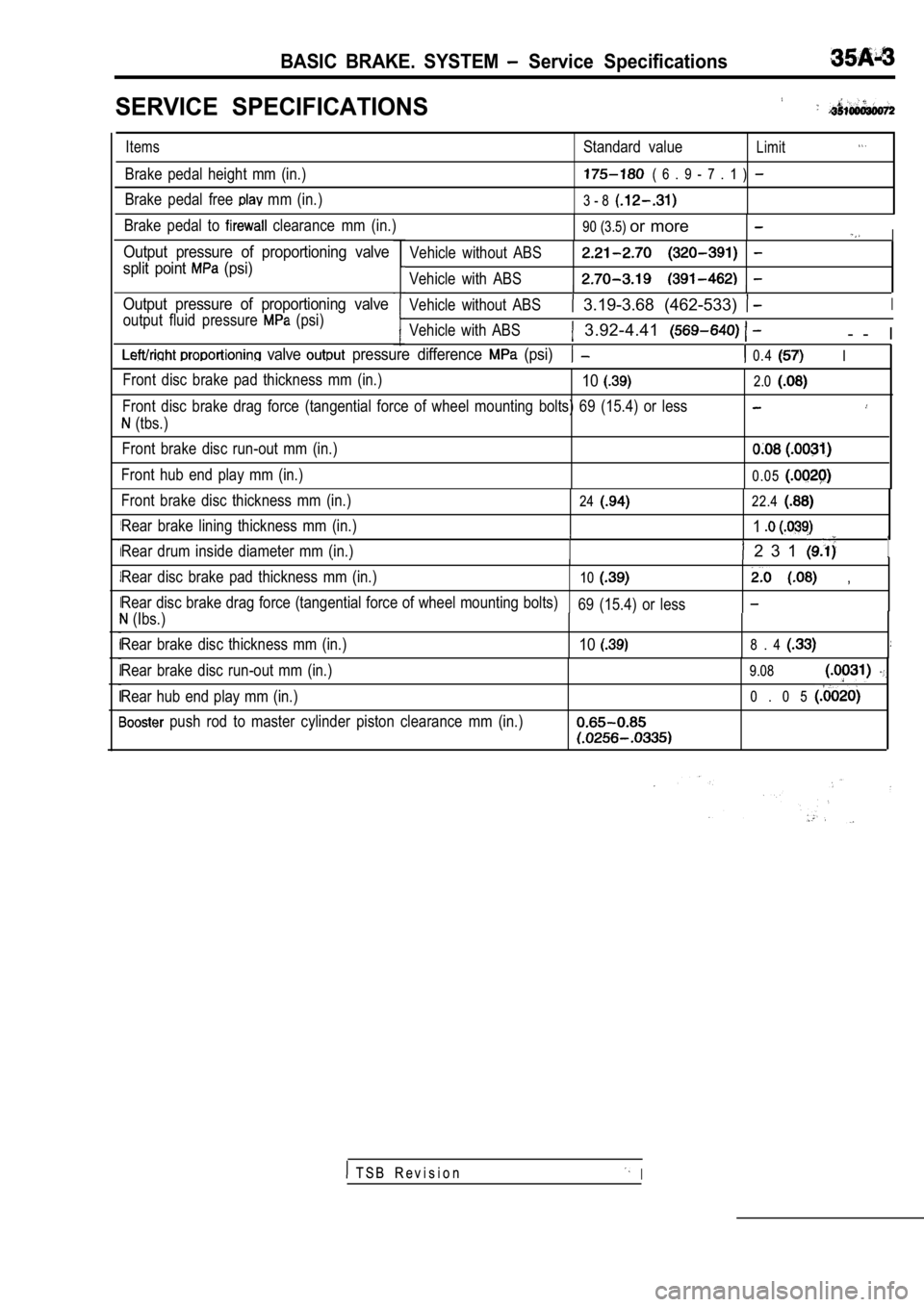
BASIC BRAKE. SYSTEM Service Specifications
SERVICE SPECIFICATIONS
ItemsStandard valueLimit
Brake pedal height mm (in.) ( 6 . 9 - 7 . 1 )
Brake pedal free mm (in.)3 - 8
Brake pedal to clearance mm (in.)90 (3.5) or moreI
Output pressure of proportioning valve
split point
(psi)
Output pressure of proportioning valve
output fluid pressure (psi) Vehicle without ABS
Vehicle with ABSII
Vehicle without ABS 3.19-3.68 (462-533) I
Vehicle with ABS 3.92-4.41 - - I
valve pressure difference (psi) 0.4 I
Front disc brake pad thickness mm (in.)10
Front disc brake drag force (tangential force of wh
eel mounting bolts) 69 (15.4) or less
(tbs.)
Front brake disc run-out mm (in.)
Front hub end play mm (in.)
2.0
0.05
Front brake disc thickness mm (in.)
Rear brake lining thickness mm (in.)
Rear drum inside diameter mm (in.)2422.4
1
2 3 1 1
Rear disc brake pad thickness mm (in.)10 ,
Rear disc brake drag force (tangential force of whe el mounting bolts)
69 (15.4) or less
(Ibs.)
Rear brake disc thickness mm (in.)
108 . 4
Rear brake disc run-out mm (in.)
Rear hub end play mm (in.)
push rod to master cylinder piston clearance mm (i n.)
9.08
0 . 0 5
T S B R e v i s i o nI
Page 1642 of 2103
BASIC BRAKE SYSTEM Tools
LUBRICANTS
,,
Brake fluid
Brake piston seal Specified lubricant or
Repair kit grease
Slide pin boot and slide pin bush inner surfaces
,
Brake piston boot inner surfaces.
Lock pin boot inner surfaces
Guide pin boot inner surfaces
Piston boot mounting grooves
Piston cup surface
Rear brake shoe and backing plate contact surfacesB r a k e g r e a s e 1
Shoe and lining assembly and auto adjuster assembly con-
tact surfaces
“.Shoe and lever assembly and auto adjuster assembly con-
tact surfaces
. .. . .
SEALANT
Items
Thread part fitting
Vacuum switch Specified sealant ATD Part No. 8861 or equivalent sealant ,
.
SPECIAL TOOLS
ToolTool number and nameApplication
T S B R e v i s i o n
Brake tool set General service tool
Compressing front disc
piston
Installation of drum brake
wheel cylinder piston cup
Removal and installation of
front hub
Front hub remover and
installer
Page 1643 of 2103
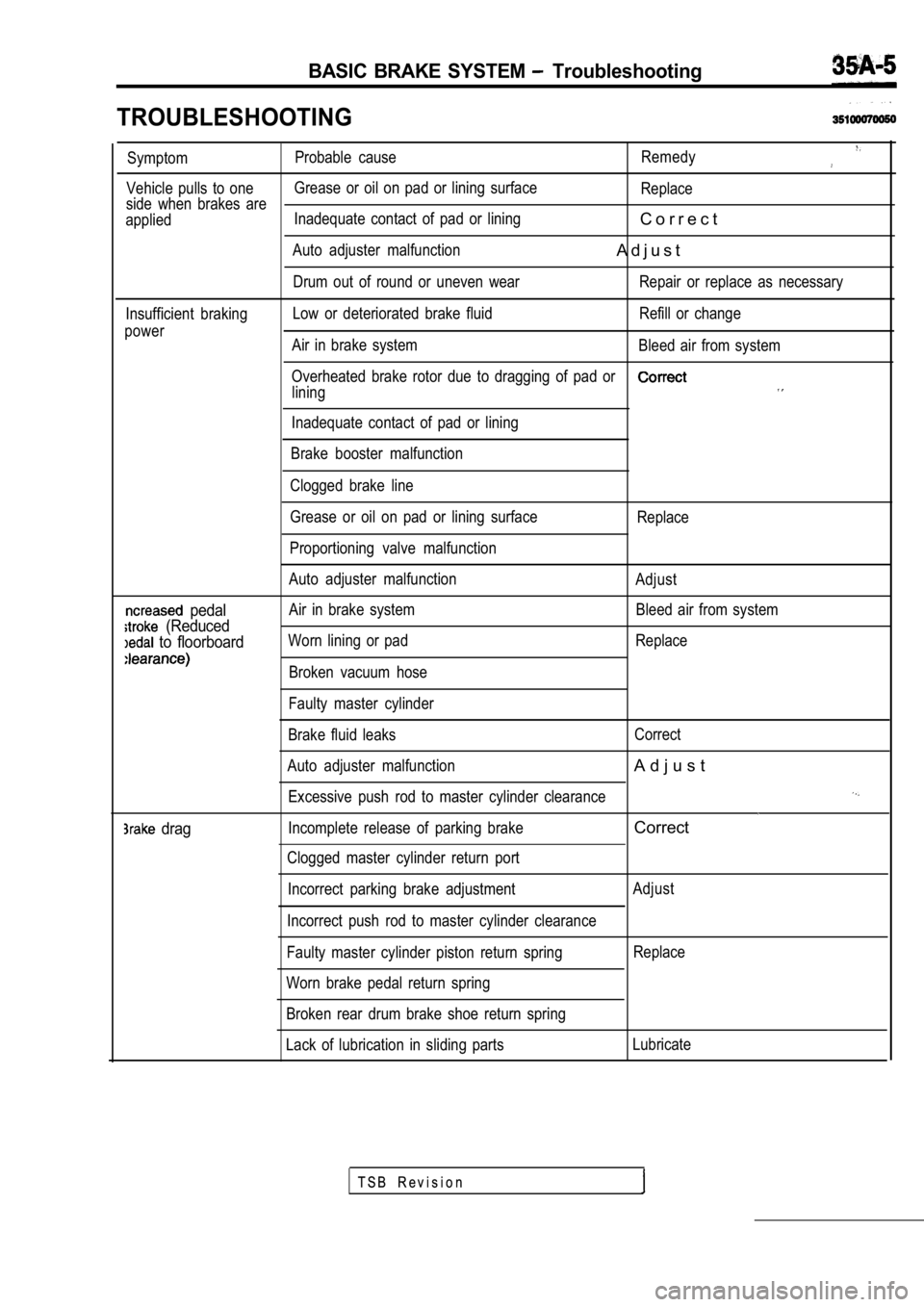
BASIC BRAKE SYSTEM Troubleshooting
TROUBLESHOOTING
SymptomProbable cause
Remedy
Vehicle pulls to oneGrease or oil on pad or lining surface
Replace
side when brakes are
applied Inadequate contact of pad or lining
C o r r e c t
Auto adjuster malfunctionA d j u s t
Drum out of round or uneven wear Repair or replace a
s necessary
Insufficient braking Low or deteriorated brake fluid Refill or change
power Air in brake system Bleed air from system
Overheated brake rotor due to dragging of pad or
lining
Inadequate contact of pad or lining
Brake booster malfunction
Clogged brake line
pedal
(Reduced
to floorboard
drag
Grease or oil on pad or lining surface
Proportioning valve malfunction
Auto adjuster malfunction
Air in brake system
Worn lining or pad
Broken vacuum hose
Faulty master cylinder
Brake fluid leaks
Auto adjuster malfunction Excessive push rod to master cylinder clearance
Incomplete release of parking brake
Clogged master cylinder return port
Incorrect parking brake adjustment
Incorrect push rod to master cylinder clearance
Faulty master cylinder piston return spring
Worn brake pedal return spring
Broken rear drum brake shoe return spring Replace
Adjust Bleed air from system
Replace
Correct
A d j u s t
Correct
Adjust Replace
Lack of lubrication in sliding parts Lubricate
T S B R e v i s i o n
Page 1644 of 2103
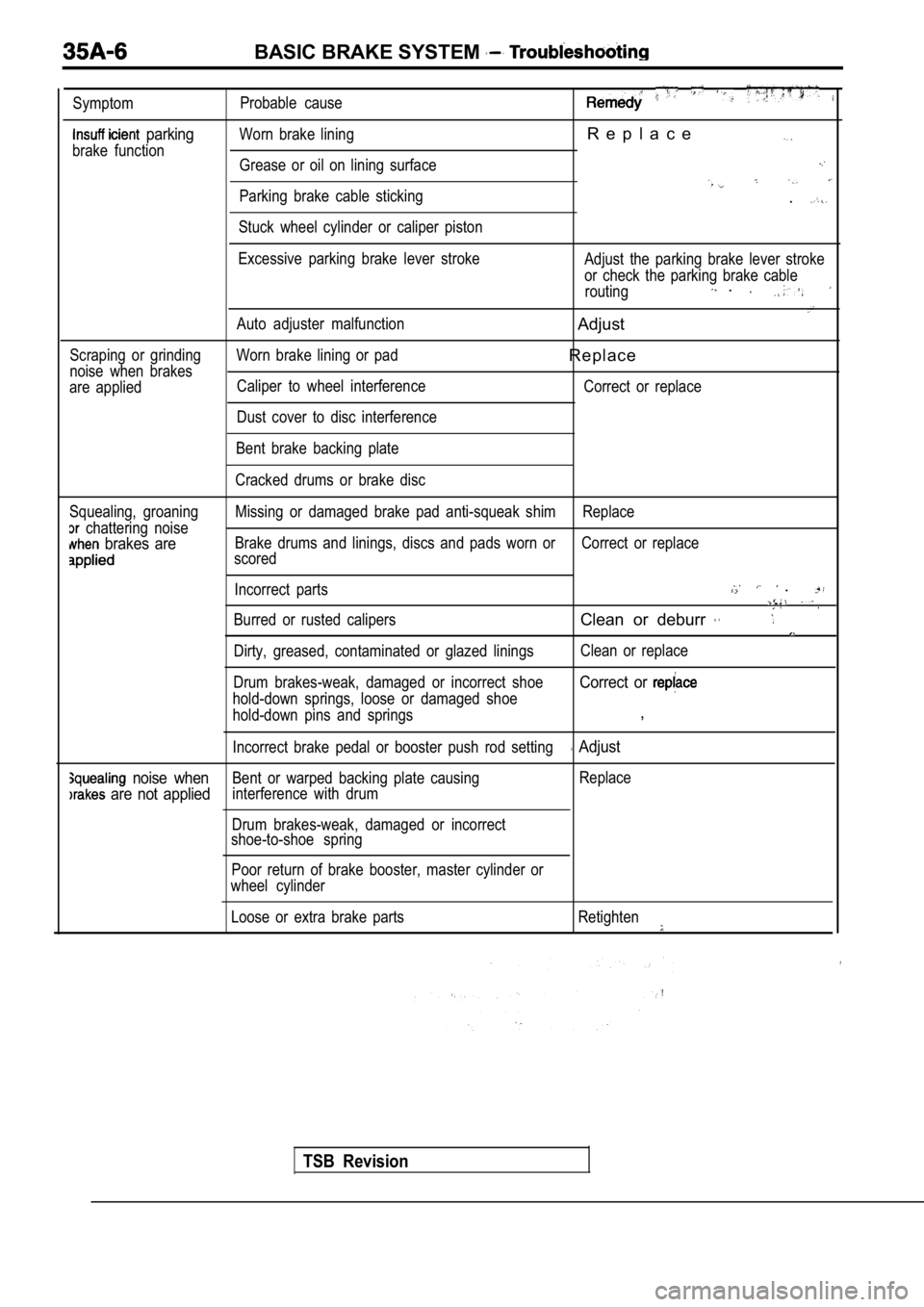
BASIC BRAKE SYSTEM
Symptom
parking
brake functionProbable cause
Worn brake lining
R e p l a c e
Grease or oil on lining surface
Parking brake cable sticking
Stuck wheel cylinder or caliper piston.
Scraping or grinding
noise when brakes
are applied Excessive parking brake lever stroke
Auto adjuster malfunction
Worn brake lining or pad Caliper to wheel interference
Dust cover to disc interference Adjust the parking brake lever stroke
or check the parking brake cable
routing
.
Adjust
R e p l a c e
Correct or replace
Bent brake backing plate
Cracked drums or brake disc
Squealing, groaning
chattering noise
brakes are
Missing or damaged brake pad anti-squeak shim Replac e
Brake drums and linings, discs and pads worn or Corr ect or replace
scored
Incorrect parts
.
Burred or rusted calipersClean or deburr
Dirty, greased, contaminated or glazed linings Clean or replace
Drum brakes-weak, damaged or incorrect shoe
hold-down springs, loose or damaged shoe
Correct or
hold-down pins and springs,
Incorrect brake pedal or booster push rod setting Adjust
noise whenBent or warped backing plate causing Replace
are not appliedinterference with drum
Drum brakes-weak, damaged or incorrect
shoe-to-shoe spring
Poor return of brake booster, master cylinder or
wheel cylinder
Loose or extra brake parts Retighten
TSB Revision
Page 1645 of 2103
BASIC BRAKE SYSTEM Troubleshooting .
SymptomProbable cause Remedy
Squealing noise when
positioning of pads in caliper Correct
brakes are not appliedImproper installation of support mounting to
caliper body
Improper machining of drum causing interferenceReplace drum
with backing plate or shoe
Disc brakes-rusted, stuck Lubricate or replace
Worn, damaged or insufficiently lubricated wheel
bearings
Incorrect brake pedal or booster push rod setting Adjust
Groaning clicking orStones or foreign material trapped inside wheel
Remove stones,
rattling noise when covers
brakes are not applied
Loose wheel nuts Retighten
Disc brakes-loose installation bolt
Worn, damaged or dry wheel bearings Lubricate or replace
Disc brakes-failure of anti-rattle shim
R e p l a c e
Disc brakes-wear on sleeve
Incorrect brake pedal or booster push rod settingA d j u s t
,
TSB Revision
Page 1646 of 2103
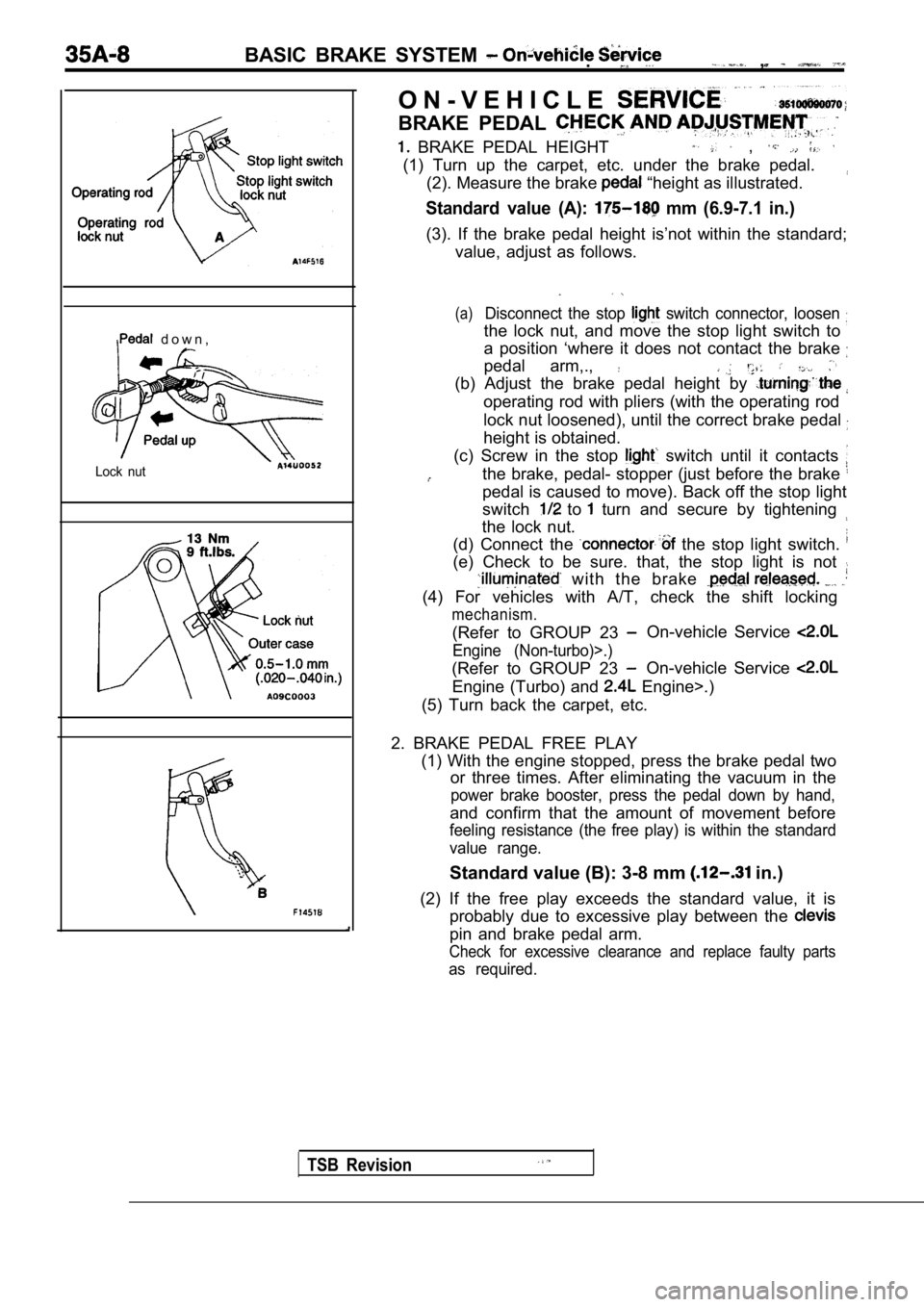
BASIC BRAKE SYSTEM .,
d o w n ,
Lock nut
TSB Revision
O N - V E H I C L E
BRAKE PEDAL
BRAKE PEDAL HEIGHT ,
(1) Turn up the carpet, etc. under the brake pedal.(2). Measure the brake
“height as illustrated.
Standard value (A): mm (6.9-7.1 in.)
(3). If the brake pedal height is’not within the st andard;
value, adjust as follows.
(a)Disconnect the stop switch connector, loosen
the lock nut, and move the stop light switch to
a position ‘where it does not contact the brake
pedal arm,.,
(b) Adjust the brake pedal height by
operating rod with pliers (with the operating rod
lock nut loosened), until the correct brake pedal
height is obtained.
(c) Screw in the stop
switch until it contacts
the brake, pedal- stopper (just before the brake
pedal is caused to move). Back off the stop light
switch
to turn and secure by tightening
the lock nut.
(d) Connect the
the stop light switch.
(e) Check to be sure. that, the stop light is not
with the brake
(4) For vehicles with A/T, check the shift locking
mechanism.
(Refer to GROUP 23 On-vehicle Service
Engine (Non-turbo)>.)
(Refer to GROUP 23 On-vehicle Service
Engine (Turbo) and Engine>.)
(5) Turn back the carpet, etc.
2. BRAKE PEDAL FREE PLAY (1) With the engine stopped, press the brake pedal two
or three times. After eliminating the vacuum in the
power brake booster, press the pedal down by hand,
and confirm that the amount of movement before
feeling resistance (the free play) is within the st andard
value range.
Standard value (B): 3-8 mm in.)
(2) If the free play exceeds the standard value, it is
probably due to excessive play between the
pin and brake pedal arm.
Check for excessive clearance and replace faulty pa rts
as required.